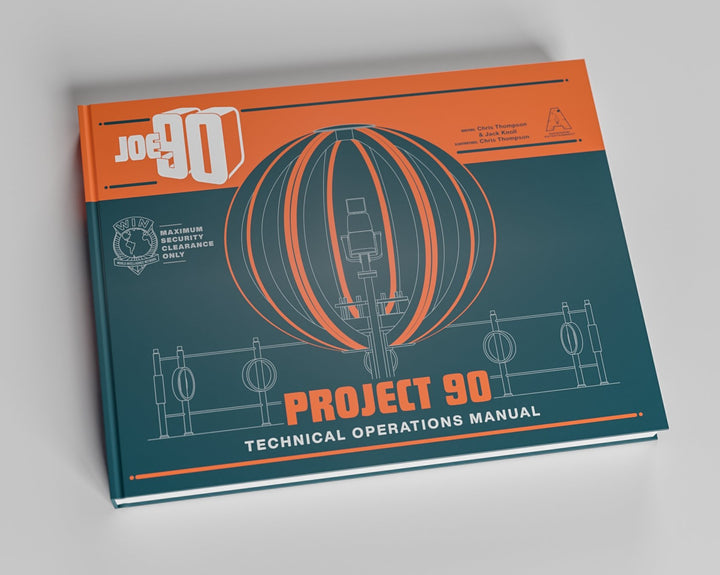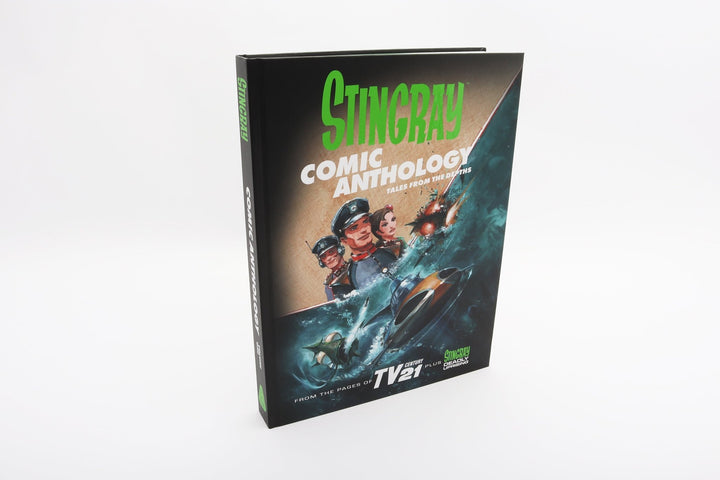Tomorrow's News Today: Fireball XL5 in TV21
Share
Share

The daring excitement and cosmic adventures that the worlds of Gerry Anderson are celebrated for aren’t just confined to the TV screen. Many of Gerry Anderson’s creations enjoyed further adventures across novels, annuals, audio dramas, and comics, most famously in the pages of TV Century 21. We’re investigating the untold histories of Gerry Anderson’s greatest creations found in the newspaper of the future, continuing with Fireball XL5! This report comes to you transmitted via laser-accelerated spectro-view!
Earth in Peril!

As we've previously explored, Stingray was clearly designed to be the star TV tie-in strip in the pages of TV Century 21. However, in terms of narrative and artistic quality, the Stingray strip quickly became matched by Fireball XL5. The TV21 adventures of Steve Zodiac, Doctor Venus, and Professor Mat Matic rapidly began to outshine the Stingray adventures as an ambitious, intelligent, and darkly exciting military sci-fi saga that was light years ahead of its archaic TV counterpart. Mercifully, Zoonie is nowhere to be found in these adventures!
By the time TV21 hit the newsstands in January 1965, Fireball XL5 was already just over two years old. Perhaps not the longest stretch of time, but by this point, A.P. Films was marching ahead with their latest TV production, Thunderbirds, itself quite an evolution from the black-and-white world of Fireball XL5. Nevertheless, regular repeats of the series on regional television across the UK ensured that the series remained in the public eye, no doubt bolstering Fireball XL5's prestigious status in TV21 as one of its definitive strips. Fireball XL5's importance in TV21 was also reflected by its regular command of the comic's newspaper-styled front pages. For a great many fans, TV21's sensationalist headlines and gorgeous interior artwork were most likely the earliest instances of seeing the craft in colour.
Fireball XL5's comic strip adventures had already begun with a regular strip in the pages of TV Comic between 1962 and 1964, but under editor Alan Fennell, Fireball XL5 blasted off into markedly different territory in his own comic. Fennell was the chief writer on Fireball XL5 throughout the comic's first year and initially wrote the strip as a faithful carryover from the TV series. Some of these early adventures are admittedly lightweight material, involving overgrown animals terrorising Earth-based cities and abominable space snowmen. However, the strip peaks early with the 1965 storyline 'The Astran Assassination' (#15-#26). As another reminder of Fireball XL5's importance to TV21, this politically motivated thriller remains the only TV21 storyline to fully embrace the comic's shared world by dovetailing multiple ongoing strips into a single narrative.
Barely two years after the assassination of US President John F. Kennedy, this boldly topical storyline sees Steve Zodiac tasked with tracking down enemy agents who assassinate the Kaplan, leader of the Astrans, whilst on a peacekeeping visit to Earth. It's a race against time for Steve to trace the assassins before the Astrans declare war on the Earth Space Empire. It's a captivating adventure that pushes its narrative scope further with a strong anti-war message.

Helping to make TV21's Fireball XL5 strip a universally celebrated effort is the artwork of the legendary Mike Noble. His meticulous artwork imbue these storylines with an engrossing maturity, while his airbrush techniques make his cosmic worlds come to life in ways few other TV21 artists were able to convincingly pull off. Throughout his time illustrating Fireball XL5 (and later Zero X and Captain Scarlet), he displayed a playful preference for capturing his characters in dramatic lighting, with characters illuminated by the banks of technological apparatus when piloting their fantastic machines of the future. Noble's glossy, photorealist artistic style would be exquisitely served in TV21's photogravure printing format.
TV21's Fireball XL5 strip would feature the work of a revolving line-up of artists, but Noble remains most closely associated with the strip. Noble illustrates 11 out of Fireball XL5's 20 comic strip adventures, joining with the second story, 'The Vengeance of Saharis' (#6-#14) and initially contributing up to 'The Abominable Snowmen' (#34-#39), before illustrating the strip's peak period between 'Time Slip!' (#44-#51) and 'Planet Slavers' (#79-86). He'd also illustrate 'Planet of Volkanos' (#90-#100) and the first four instalments of 'Architects of Peace' (#105-117). Prior to his comics career, Noble began his artistic career during his National Service between the late 1940s and early 1950s, illustrating military hardware, a skill that would prove invaluable in depicting the space-age technology of TV21.
Fireball Explosion!

Fireball XL5's undeniable golden period in TV21 arguably remains the greatest homerun of stories the comic ever told. The stories told between November 1965 and December 1966 are unrestrained in their galactic scope, showing Fireball XL5 at the peak of its powers as it patrols the cosmos, defending the stars from malevolent alien terror. Storylines range from accidental time travel to deceptive planetary takeovers and organised space piracy. Even the lesser storylines such as 'Meteorite Menace' (#64-#70), a generic alien invasion caper in which nothing is learned of the aliens' motives for attacking Space City, are electrified by rapid-fire pacing to the scriptwriting, coupled with Noble's dependably breath-taking art.
Noteworthy highlights from this era are 'Time Slip!', in which a new revolutionary engine system accidentally propels Fireball XL5 100 years back in time, and, in a delightful subversion of roles, it's the Fireball crew themselves who are treated as the alien invaders. This storyline prizes open numerous intriguing world-building details of TV21's shared universe, including the cataclysmic events of the Great Atomic War. 'Planet Slavers' sees the XL5 crew stranded on a primitive alien world and deprived of the Fireball craft itself. The crew's investigation of the enemy race Femians' exploitation of the planet's cavemen-like inhabitants for slavery results in Steve, Venus, and Mat forging an uneasy alliance with the cavemen to bring the Femians to justice.
'Sword of Damacles' (#71-#78) commands a hugely convincing claim in being the greatest TV21 storyline ever created. This cosmic interpretation of the Greek legend of Damocles (here renamed Damacles, for whatever reason), a warning of the constant dangers faced by those in power, reimagines the parable's events through the lens of deadly space pirates. In 'Sword of Damacles', a mysterious organisation is hijacking spacecraft in an effort to become supreme rulers of the stars, but their mission accelerates by blackmailing the World Space Patrol for the capture of Fireball XL5 in exchange for the life of Venus. Steve must rescue Venus and uncover the deadly truth behind this elusive outfit.

It's also during this period that Noble's art visibly improves. His work was rarely sub-par, but his earlier work throughout the storylines in 1965 made use of quite light, pastel-esque colours and less dramatic emphasis on mechanical hardware. As these later adventures show, his brushwork becomes more confident and vigorous, and his aptitude for technical detail becomes greatly enhanced, serving the drama and action of these stories superbly.
Noble's depiction of the various alien civilisations and monsters seen during this period also benefits from this apparent development in his artistic style. Despite his background illustrating real-world engineering and non-sci-fi comics (which included an eclectic range of titles such as Robin, Woman, Lone Ranger for Express Weekly, and Popeye for TV Comic), Noble adapts to the imaginatively futuristic world of TV21 with enjoyable aplomb. His thick inking and raw colouring of the ferociously monstrous tentacle creatures from 'Meteorite Menace' make for awesomely grotesque beings, while the far more humanoid Volkanians, Styracians, and Femians are executed with compelling visual style.

After Fennell's tenure on the strip, TV21's assistant editor, Tod Sullivan, is most closely associated with scripting Fireball XL5 in TV21. However, in the Century 21: Classic Comic Strips from the Worlds of Gerry Anderson: Menace from Space reprint collection, the 'Sword of Damacles' storyline is credited to TV21 script editor Angus Allan. Given the strong consistency of storylines during this era, could it be possible that Allan had a far greater influence on the Fireball XL5 strip than history suggests? Whichever of TV21's editors and writers were involved in scripting Fireball XL5, there's a razor-sharp focus on quality storytelling throughout this era.
Shadows of Andromeda

Unfortunately, 'Planet of Volkanos' would mark Noble's permanent departure from the Fireball XL5 strip, eventually moving to become the initial resident artist on the Zero X strip. This in turn would last roughly a year before he moved on once again to illustrate several early classic storylines of Captain Scarlet's TV21 strip. Noble's departure from Fireball XL5 would coincide with an unappealing downgrade in the storytelling. There's a definite sense of varying creative powers at the steering wheel.
Following his departure, Don Lawrence would bring a sterner atmosphere to the proceedings, somehow lacking Noble's dynamic fluidity. Surprisingly, Lawrence would depict the characters closer to their caricatured puppet counterparts, a stylistic choice that Noble drastically avoided. Eventually, the strip falls between a revolving line-up of talents, including Tom Kerr and Colin Andrew, neither of whom possess Noble's captivating skills. Remarkably, a handful of these later-career stories call back to earlier adventures in Fireball XL5's career. 'The Bitterest Pil' (#128-#135) is an unforeseen sequel to 'The Vengeance of Saharis', in which Steve Zodiac grapples with a robot clone of the humanoid warmonger Pil.
Fireball XL5's final comic strip adventure in TV21 at least secures a partial success for the strip to end on. 'Shadow of Andromeda' (#149-#154) pushes back against the frivolous space fantasy of the twilight-era strips, tapping into the politically influenced material that made earlier storylines so exciting. Sadly, the story itself is a rather unashamed rehash of the much superior 'Astran Assassination' adventure, a sign perhaps that inspiration was finally running dry on Fireball XL5's comic adventures.
TV21 would unexpectedly rejuvenate Fireball XL5 at the beginning of 1968 by transforming the strip into a series of ongoing short text stories. Mike Noble's artwork is peppered throughout these stories, but rather than serve as original illustrations, pre-existing art from his TV21 strips is recycled here. There's even some of Noble's art from the Captain Scarlet strip and Frank Bellamy's Thunderbirds art recontextualised here.

Fireball XL5's three-year tenure in TV21 drew to a weary end in issue #167 with the standalone short story 'Grounded!' After a handful of serialised text stories, this brief adventure still manages to pack in a strong 'finale' vibe. Following on from the events of the previous text stories, the Fireball crew is targeted by a Bereznik Secret Service crew, led by a maniacal captain who leads his men on a suicide mission to kill Steve Zodiac once and for all. Steve, Venus, and Mat manage to escape, but Fireball XL5 itself is completely destroyed, lending a truly endgame attitude to the story. Nonetheless, the story and Fireball XL5 itself end with the optimistic declaration by Commander Zero that the craft will be rebuilt and that Steve Zodiac's adventures will continue...
Countdown to Fireball XL5
Like many other classic Anderson puppet series, Fireball XL5 would receive new adventures in the pages of Countdown in the early 1970s. The TV21 adventures would be brought back into action when they were chosen by Alan Fennell to bulk out the pages of Fleetway's successful Thunderbirds comic in the early 1990s. Most of the Anderson Fleetway comics featured classic TV21 strips recycled for new and old readers, but where the Thunderbirds and Stingray strips were published in a mostly chronological fashion, Fennell instead chose to focus on reprinting the Fireball XL5 stories illustrated by Mike Noble.
Much like Stingray's classic comic adventures, Fireball XL5's TV21 stories became regular features of various Gerry Anderson comic compilations. However, it wouldn't be until the series' 60th anniversary in 2022 that the entirety of Fireball XL5's TV21 comics (minus the later text stories) were collected in Anderson Entertainment's Fireball XL5 Comic Anthology. This definitive collection also includes a brand new storyline written and illustrated by Lee Sullivan, 'Interplanetary Rescue', which tells a combined Fireball XL5/Stingray/Thunderbirds/Captain Scarlet comic adventure that also links together several classic TV21 story arcs.

At their best, Fireball XL5's TV21 adventures are a stunning reinvention of the television series, eschewing the admittedly juvenile attitude of the original series and embracing a thrillingly extreme attitude that rarely talked down to its young readership. Storylines benefitted from grounded premises ranging from political thrillers to anti-war dangers, nuclear warnings, and the exploitation of slavery for corporate greed. Even the more fanciful elements, such as time travel and alien monsters, are treated with a straight-faced severity.
With its consistently enthralling adventures and spectacular artwork, Fireball XL5 remains one of TV21's most fully flourished and cosmically adventurous comic strips!
To be the first to hear about the latest news, exclusive releases and show announcements, sign up to the Anderson Entertainment newsletter!




![Fireball XL5 World Space Patrol Technical Operations Manual [HARDCOVER BOOK] - The Gerry Anderson Store](http://gerryanderson.com/cdn/shop/files/fireball-xl5-world-space-patrol-technical-operations-manual-hardcover-book-290050.jpg?v=1711729272&width=720)



![Stingray Comic Anthology Volume Two – Battle Lines [HARDCOVER] - The Gerry Anderson Store](http://gerryanderson.com/cdn/shop/files/stingray-comic-anthology-volume-two-battle-lines-hardcover-107681.jpg?v=1738856151&width=720)
![Space: 1999 and UFO Book Bundle - Signed Limited Editions [HARDCOVER NOVELS] - The Gerry Anderson Store](http://gerryanderson.com/cdn/shop/files/space-1999-and-ufo-book-bundle-signed-limited-editions-hardcover-novels-589446.jpg?v=1718836845&width=720)
![Stingray WASP Technical Operations Manual Special Limited Edition [HARDCOVER BOOK] - The Gerry Anderson Store](http://gerryanderson.com/cdn/shop/files/stingray-wasp-technical-operations-manual-special-limited-edition-hardcover-book-991914.jpg?v=1732922875&width=720)
![Stingray: The Titanican Stratagem – Signed Limited Edition [HARDCOVER NOVEL] - The Gerry Anderson Store](http://gerryanderson.com/cdn/shop/files/stingray-the-titanican-stratagem-signed-limited-edition-hardcover-novel-129251.jpg?v=1740558711&width=720)






